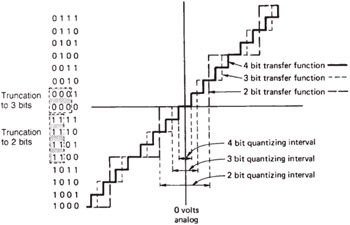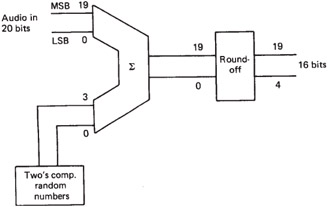2.11 Requantizing and Digital Dither
| | ||
| | ||
| | ||
2.11 Requantizing and Digital Dither
The advanced ADC technology now available allows 20 or more bits of resolution to be obtained in audio. The situation then arises that an existing 16-bit device such as a digital recorder needs to be connected to the output of an ADC having greater word length. In a similar fashion digital video equipment has recently moved up from eight- to ten-bit working with the result that ten-bit signals are presented to eight-bit devices. In both cases the words need to be shortened in some way.
When a sample value is attenuated, the extra low-order bits that come into existence below the radix point preserve the resolution of the signal. The dither in the least significant bit(s) linearizes the system. The same word extension will occur in any process involving multiplication, such as mixing or digital filtering. It will subsequently be necessary to shorten the word length. Clearly the high-order bits cannot be discarded in two's complement as this would cause clipping of positive half cycles and a level shift on negative half cycles due to the loss of the sign bit. Low-order bits must be removed instead. Even if the original conversion was correctly dithered, the random element in the low-order bits will now be some way below the end of the intended word. If the word is simply truncated by discarding the unwanted low-order bits or rounded to the nearest integer the linearizing effect of the original dither will be lost. In audio the result will be low-level distortion; in video the result will be contouring .
Shortening the word length of a sample reduces the number of quantizing intervals available without changing the signal amplitude. As Figure 2.32 shows, the quantizing intervals become larger and the original signal is requantized with the new interval structure. This will introduce requantizing distortion having the same characteristics as quantizing distortion in an ADC. It then is obvious that when shortening the word length of a 20-bit convertor to 16 bits, the four low-order bits must be removed in a way that displays the same overall quantizing structure as if the original convertor had been only of 16-bit word length. It will be seen from Figure 2.32 that truncation cannot be used because it does not meet the above requirement but results in signal dependent offsets because it always rounds in the same direction. Proper numerical rounding is essential in audio and video applications. Rounding in two's complement is a little more complex than in pure binary. Requantizing by numerical rounding accurately simulates analog quantizing to the new interval size. Unfortunately the 20-bit convertor will have a dither amplitude appropriate to quantizing intervals one-sixteenth the size of a 16-bit unit and the result will be highly non-linear.

Figure 2.32: Shortening the word length of a sample reduces the number of codes which can describe the voltage of the waveform. This makes the quantizing steps bigger, hence the term requantizing. It can be seen that simple truncation or omission of the bits does not give analogous behaviour. Rounding is necessary to give the same result as if the larger steps had been used in the original conversion.
In practice, the word length of samples must be shortened in such a way that the requantizing error is converted to noise rather than distortion. One technique that meets this requirement is to use digital dithering 15 prior to rounding. This is directly equivalent to the analog dithering in an ADC.
Digital dither is a pseudo-random sequence of numbers . If it is required to simulate the analog dither signal of Figure 2.24, then it is obvious that the noise must be bipolar so that it can have an average voltage of zero. Two's complement coding must be used for the dither values to obtain this characteristic.
Figure 2.33 shows a simple digital dithering system (i.e. one without noise shaping) for shortening sample word length. The output of a two's complement pseudo-random sequence generator of appropriate word length is added to input samples prior to rounding. The most significant of the bits to be discarded is examined in order to determine whether the bits to be removed sum to more or less than half a quantizing interval. The dithered sample is either rounded down, that is, the unwanted bits are simply discarded, or rounded up, that is the unwanted bits are discarded but 1 is added to the value of the new short word. The rounding process is no longer deterministic because of the added dither that provides a linearizing random component.

Figure 2.33: In a simple digital dithering system, two's complement values from a random number generator are added to low-order bits of the input. The dithered values are then rounded up or down according to the value of the bits to be removed. The dither linearizes the requantizing.
If this process is compared with that of Figure 2.24 it will be seen that the principles of analog and digital dither are identical; the processes simply take place in different domains using numbers that are rounded or voltages that are quantized as appropriate. In fact quantization of an analog dithered waveform is identical to the hypothetical case of rounding after bipolar digital dither where the number of bits to be removed is infinite, and remains identical for practical purposes when as few as eight bits are to be removed. The probability density of the pseudo-random sequence is important. Vanderkooy and Lipshitz 15 found that uniform probability density produced noise modulation, in which the amplitude of the random component varies as a function of the amplitude of the samples. A triangular probability density function obtained by adding together two pseudo-random sequences eliminated the noise modulation to yield a signal-independent white-noise component in the least significant bit. It is vital that such steps are taken when sample word length is to be reduced. More recently, sequences yielding signal-independent noise with a weighted frequency component have been used to improve the subjective effects of the noise component leading to a perceived reduction in noise.
| | ||
| | ||
| | ||
EAN: 2147483647
Pages: 120